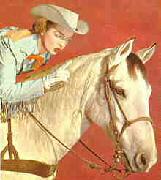The sight of blood may unnerve you, but maintaining your presence
of mind can save your horse's life.
The following suggestions should be viewed as guidelines:
1. Catch and calm your horse to prevent further injury. Move the
horse to a stall or other familiar surroundings if this is
possible without -causing distress or further injury to the
horse. Providing hay or grain can also be a good distraction.
2. Get help before attempting to -treat or evaluate A wound. It
can be difficult and very dangerous to try and inspect or clean a
wound without someone to hold the horse. You cannot help your
horse if you are seriously injured yourself
3. Evaluate the location, depth, and severity of the wound. Call
your veterinarian for a recommendation anytime you feel your
horse-is in need of emergency care. Here are some examples of
situations where your Vet should be called:
A. There appears to be excessive bleeding
B. The entire skin thickness has been penetrated.
C. The wound occurs near or over a joint.
D. Any structures underlying the skin are visible.
E. A severe wound has occurred in the lower leg or below knee or hock level.
G. The wound is severely contaminated
4. Consult with your veterinarian regarding a recommendation
before you attempt to clean the wound or remove debris or
penetrating objects, as you may precipitate uncontrollable
bleeding or do further damage to the wound. Large objects
should be stabilized to avoid damaging movement if possible.
Don't put anything on the wound except a compress or cold water.
5. Stop the bleeding (This may be the FIRST step, if the
bleeding is profuse!) by covering the wound with a sterile,
absorbent pad (not cotton), applying firm, steady, even pressure
to the wound.
6. Do not medicate or tranquilize the horse unless specifically
directed by your veterinarian, If the horse has suffered
severe blood loss or shock, the administration of certain drugs
can be life-threatening.
7. If the eye is injured, do not attempt to treat- Await your
veterinarian.
8. If a horse steps on a nail or other sharp object, and it
remains embedded in the hoof, first clean the hoof Consult with
your veterinarian regarding a recommendation before you remove
the nail. If your veterinarian advises, carefully remove the nail
to prevent the horse from stepping on it and driving it deeper
into the hoof cavity. As you remove it, be sure to mark the exact
point and depth of entry with tape and/or a marker so the
veterinarian can access the extent of the damage. Apply
antiseptic to the wound, and wrap to prevent additional
contamination.
9. All horses being treated for lacerations or puncture wounds
will require a lockjaw booster.

Other Horse Emergencies
There are far too many types of emergencies - from heat stroke to
hyperkalemic periodic paralysis, bone fractures to snake bits,
foaling difficulties, to colic - to adequately cover them all.
However, regardless of the situation, it's important to remember
these points:
1. Keep the horse as calm as possible. Your own-calm behavior
will help achieve this.
2. Move the animal to a safe area where it is unlikely to be
injured should it go down.
3. Get someone to help you , and delegate responsibilities, such
as calling the veterinarian, retrieving the first aid kit,
holding the horse, etc.
4. Notify your veterinarian immediately- Be prepared to-provide
specific information about the horse's condition, as mentioned
above, and other data that will help your practitioner assess the
immediacy of the danger and instruct you in how to proceed.
5. Listen closely and follow your equine practitioner's
instructions.
6. Do not administer drugs, especially tranquilizers or
sedatives, unless specifically instructed to do so by the
veterinarian.
A great big thank you goes to Tidewater Veterinary Hospital for
supplying the information listed and stated in the booklet, as
well as agreeing to help supply products for the first aid kits.
Please keep them in mind when you need help and materials to
refill your first aid kits.
(Information was taken from a brochure called Emergency Care
developed by the American Association of Equine Practitioner's
through a grant from Bayer Corporation.)
Bar None Farm is a breeding and training facility. We have been
involved in the POA breeding for over fifteen years. We spent 5
years to find the perfect POA Stallion to head our breeding
program along with our top quality mares. We have a fine
selection of foals offered for sale each fall. We offer breeding
services, mare care, foaling, and foal handling. We work hand in
hand with our local veterinarian to provide the best care for you
horse. Cindy Hallett, a John Lyons Certified Trainer, heads our
training program. We offer everything from starting horses to
training the trail horses, the show horses, or the pleasure
horses, and conditioning Halter horses, as well as showing the
halter and performance horses. www.barnonefarm.com/